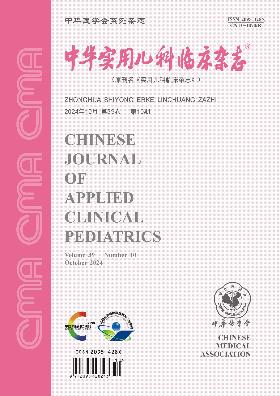儿童髓鞘少突胶质细胞糖蛋白抗体阳性中枢神经系统脱髓鞘疾病的临床特点
Q4 Medicine
引用次数: 0
摘要
目的探讨中枢神经系统脱髓鞘疾病患儿血清髓鞘少突胶质细胞糖蛋白(MOG)抗体阳性的临床特点及治疗效果。方法回顾性分析2017年3月至2019年2月在浙江大学医学院儿童医院神经内科住院的115例中枢神经系统脱髓鞘疾病患儿中28例MOG血清阳性的临床特点。结果28例患者,男10例,女18例,男女比例1.00∶1.80,中位年龄7岁9个月。临床表现多种多样,包括脑病症状,如腹泻、呕吐和嗜睡(13/28例)、视力下降(7/28例)、脊柱症状(6/28例),小脑症状,如共济失调、口齿不清(4/28例)和抽搐(2/28例)以及脑神经症状(1/28例)。在24例接受CSF检测的患者中,10例(41.7%)白细胞轻度增加,2例(8.3%)蛋白质升高,6例(25.0%)MOG抗体阳性,24例患者的CSF限制性寡克隆带均为阴性。25例(89.3%)出现脑磁共振成像(MRI)异常,包括脑白质(20/28例)、小脑(10/28例),脑灰质(9/28例),丘脑/基底节(6/28例)、脑干(6/28)、视神经(5/28例)和胼胝体(4/28例)。28例中,13例有脊髓受累,其中颈髓受累10例,胸髓受累9例,腰髓受累5例;其中8例为≥3节段的长节段性脊髓损伤。14例患者接受了视觉诱发电位检查,其中2例出现亚临床视觉障碍,临床表现无障碍。所有患者均接受大剂量甲基泼尼松治疗。16名接受丙种球蛋白治疗的患者的临床症状在急性期得到缓解。7例患者在随访期间复发,复发率为25.0%。复发患者再次接受大剂量甲基泼尼松联合丙种球蛋白治疗,临床症状可得到缓解。结论急性播散性脑脊髓炎是中枢神经系统脱髓鞘疾病和MOG血清阳性儿童的主要临床表型。脊髓病变主要累及颈段和胸段。目前该病的治疗方法包括糖皮质激素和丙种球蛋白,疗效显著,但易复发。复发后再次使用糖皮质激素和丙种球蛋白仍然有效。关键词:髓鞘少突胶质细胞糖蛋白抗体;儿童;中枢神经系统脱髓鞘疾病本文章由计算机程序翻译,如有差异,请以英文原文为准。
Clinical features of central nervous system demyelinating diseases with myelin-oligodendrocyte glycoprotein antibody positive in children
Objective
To investigate the clinical features and treatment effect of children with central nervous system demyelinating diseases and seropositivity to myelin-oligodendrocyte glycoprotein (MOG) antibody.
Methods
The clinical characteristics of 28 had seropositivity to MOG among 115 children with central nervous system demyelinating diseases and who were hospitalized at Department of Neurology, Children′s Hospital of Zhejiang University School of Medicine from March 2017 to February 2019 were retrospectively analyzed.
Results
Twenty-eight patients were included in this study, including 10 males and 18 females, with the ratio of male/female of 1.00∶1.80, and the median age of 7 years and 9 months.The clinical manifestations were diverse, including encephalopathy symptoms such as hea-dache, vomiting, and drowsiness (13/28 cases), vision loss (7/28 cases), spinal symptoms (6/28 cases), cerebellar symptoms such as ataxia, slurred speech (4/28 cases), convulsions (2/28 cases), and cranial nerve symptoms (1/28 cases). Among 24 cases who underwent CSF detection, 10 patients (41.7%) had slightly increased white blood cells, 2 patients (8.3%) had elevated protein, 6 patients (25.0%) had positive MOG antibody, and CSF-restricted oligoclonal band was negative in all 24 patients.Twenty-five cases (89.3%) showed brain magnetic resonance imaging (MRI) abnormalities, including cerebral white matter (20/28 cases), cerebellum (10/28 cases), cerebral gray matter (9/28 cases), thalamus/basal ganglia (6/28 cases), brainstem (6/28 cases), optic nerve (5/28 cases), and corpus callosum (4/28 cases). Of the 28 cases, 13 patients had spinal cord involvement, involving cervical spinal cord in 10 cases, thoracic cord in 9 cases and lumbar spinal cord in 5 cases; besides, 8 cases of them had long segmental spinal cord lesions with ≥ 3 segments.Fourteen patients received the visual evoked potentials′ examination, and the subclinical visual impairment was found in 2 of them with unobstructed clinical performance.All patients underwent high-dose Methylprednisolone therapy.The clinical symptoms of 16 patients who were treated with Gamma globulin were relieved in the acute phase.Seven patients had recurrence during the follow-up period, with the recurrence rate of 25.0%.Relapsed patients re-treated with high-dose Methylprednisolone therapy combined with Gamma globulin, clinical symptoms could be alleviated.
Conclusion
The main clinical phenotype of children with central nervous system demyelinating diseases and seropositivity to MOG is acute disseminated encephalomyelitis.The spinal cord lesions are mainly involving cervical and thoracic segments.The current treatments of this disease include glucocorticoid and Gamma globulin, which have significant effect, but the disease is easy to relapse.The re-use of glucocorticoid and Gamma globulin after relapse is still effective.
Key words:
Myelin-oligodendrocyte glycoprotein antibody; Child; Central nervous system demyelinating disease
求助全文
通过发布文献求助,成功后即可免费获取论文全文。
去求助
来源期刊

中华实用儿科临床杂志
Medicine-Pediatrics, Perinatology and Child Health
CiteScore
0.60
自引率
0.00%
发文量
14243
期刊介绍:
Chinese Journal of Applied Clinical Pediatrics ( semi-monthly ) is a core journal of paediatrics under the supervision of China Association for Science and Technology, sponsored by Chinese Medical Association and undertaken by Xinxiang Medical College. Founded in 1986, it is openly circulated both at home and abroad. The journal has several columns, such as Expert Forum, Experimental Research and Paediatric Surgery, which are mainly for paediatric medical workers and medical researchers in hospitals. Its purpose is to reflect the new theories and technologies in paediatric medicine and scientific research at home and abroad, and to promote academic exchanges.
Chinese Journal of Applied Clinical Pediatrics is a source journal of China Science Citation Database (CSCD), a core journal of Peking University, a source journal of Chinese science and technology paper statistics (China Science and Technology Core Journals), a core academic journal of RCCSE, a high-quality scientific and technical journal of China, a high-quality scientific and technical journal of China Association for Science and Technology, and a high-quality scientific and technical journal of China Biomedical Science and Technology Association. We have been published in China Biomedical Literature Database (SinoMed), China Knowledge Network, Wanfang Data Knowledge Service Platform, China Academic Journal Abstracts, Scopus Database, Chemical Abstracts (USA), Japan Science and Technology Agency (JSTA) Database, Copernicus Abstracts (Poland), Abstracts of the Centre for Agricultural and Biological Sciences (CABS) of the United Kingdom, Cambridge Scientific Abstracts ProQuest Database, WHO Medical Journal of the Western Pacific Region (WMPR), and WHO Medical Journal of the Western Pacific Region (WMPR) of the United States. We have been included in dozens of authoritative databases at home and abroad, such as WHO Western Pacific Region Index of Medicine (WPRIM), Ullrich's Guide to Periodicals, and so on.
 求助内容:
求助内容: 应助结果提醒方式:
应助结果提醒方式:


